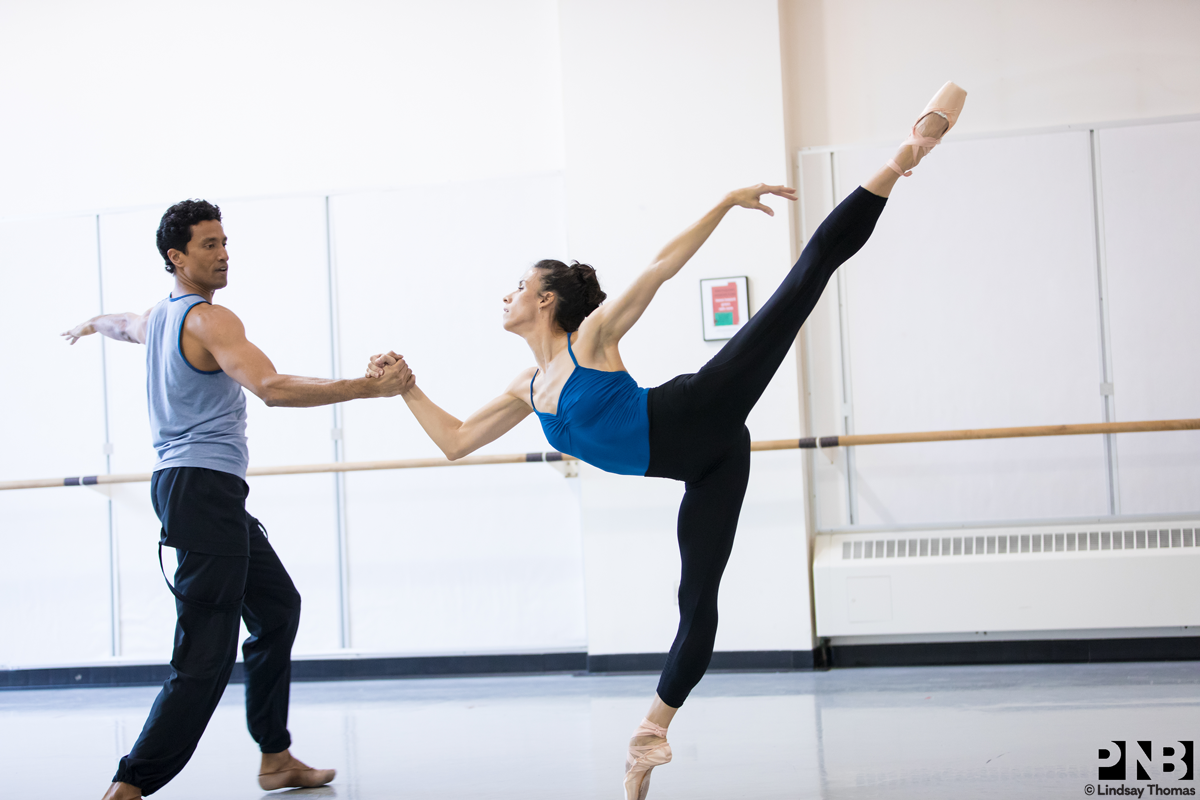WARNING: Contains mentions of suicide and sexual assault, as well as plot spoilers.
Ukrainian choreographer Yuri Possokhov’s RAkU is based on the true story of the burning of Kyoto’s Golden Pavilion in 1950, but the ballet is set in an earlier time. It tells a fictional tale of two lovers (a Princess and her husband, the Shogun), a monk, and four warriors.
Three PNB Principal dancers will alternate as the Princess this April 13-22 in EMERGENCE. PNB’s Caitlin Klask spoke to RAkU‘s leading women – Lindsi Dec, Noelani Pantastico, and Lesley Rausch – about their approach to the role and their feelings associated with performing a tragic character.

RAkU is a powerhouse piece of nearly nonstop action and emotion. Audiences will quickly realize it is not an easy ballet to perform.
“It’s very powerful,” Lindsi said. “That’s a lot for one woman to do in 20 minutes. It’s basically a full-length ballet, condensed; you hit every single emotion.”
“The ballet is exhausting, both physically and mentally,” Lesley said. “A journey from beginning to end – the Princess is onstage nearly the entire time.”
Emotions range from love to loss to trauma for the Princess. First, she performs an affectionate pas de deux with her husband, the Shogun, before he departs for war.
“Even just in subtle movements, you can feel [her] love and passion for him,” Lindsi said, noting the “liquid quality” of the pas de deux with the Shogun. “Her arm does something that’s very soft and flowy – that’s her romantic side, I think.”

The Princess is placed in the care of the Monk while her husband is at war, and her movements in their pas de deux immediately become more jagged and abrupt as she tries to escape his grasp. Filled with desire for her, he takes her by force. It is a wrenching scene accompanied by Shinji Eshima’s powerful score. When the Monk leaves her, the Princess is met by four warriors who bring news of her husband’s fate: He has died at war.
For Noelani, playing the role of a rape victim and widow is a duty she honors. “RAkU sheds a light on difficult subject matter,” she said. “To be the vessel to portray a woman unraveling is something I take very seriously.”
At the end of the ballet, the Princess lies down for a final time, committing suicide using the Shogun’s sword. In Noelani’s mind, this is her only source of control in a life devoid of power.

“The fate of the Princess is in her own hands, much like that of Juliet in Jean Christophe Maillot’s Roméo et Juliette. These female characters are worlds apart, but in the end they are both stripped of love. I can understand losing love and hope, and easing pain or wanting to remove it forever,” she said.
“The name ‘RAkU’ means pleasure, and the word ‘raku’ means comfort, relief, or ease. She realizes the only pleasure she has left is the comfort of ending it all in her own hands.”
Unlike Noelani, Lindsi has never died onstage. “I have no idea what to expect,” Lindsi said. “This is my first time going through all of this emotional inner turmoil, and I’m looking forward to the challenge. I just want to lose myself and become her.”

Her Shogun husband onstage is also her husband in real life, Karel Cruz. “Karel and I always talk about this: [When you take on a role], you become that person, you become that part. You believe you’re really that person, and everything just naturally happens. It’s organic that way.”
But for Lindsi, becoming the Princess gets tougher as soon as she finds out her husband is killed at war.

“With Karel’s and my connection, being married, I think that’s going to help with the story for our cast,” she said. She looks forward to navigating that difficult path, “whether I’ll need to pull back a little bit mentally or emotionally. I’ll probably have a couple of rehearsals where I’ll just be crying.”
Lesley considers the audience’s reaction to the themes of RAkU. “I think some people will find it hard to watch,” she said. “Unfortunately, the reality of the Princess’s devastating story is something that continues to be an issue in our culture today.”

But the dancers hope RAkU leaves audiences with a feeling of solidarity. “We’re seeing right now a movement to say it’s not okay, and we’re not going to keep it quiet anymore,” Lesley said. “Art is a very powerful tool, and I’m grateful that we can bring to the stage a ballet that represents something that’s currently becoming much more visible in our culture.
“I want the audience to see, through this piece of art, how damaging assault is,” Lesley said. “It’s time for women to be treated differently.”
Noelani wants audiences to encounter “a voyage into a territory known or unknown, where one can feel, relate, or heal.”

Acknowledging that viewing an assault onstage can be triggering for audience members, PNB hopes that through a story told by impassioned performers, RAkU can also be a vehicle both for dialogue about a challenging subject and for potential healing.
All photos © Lindsay Thomas.
